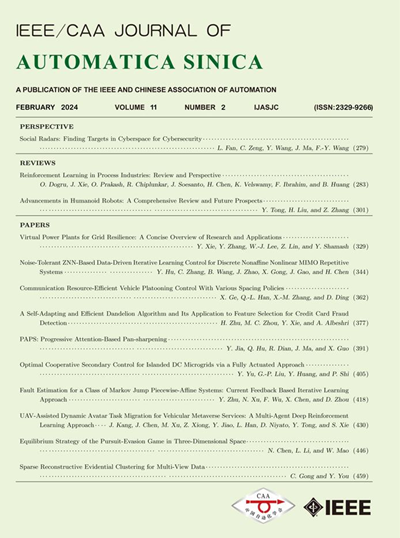高性能HIL无人机群的无抖振容错控制与故障方向识别
IF 19.2
1区 计算机科学
Q1 AUTOMATION & CONTROL SYSTEMS
引用次数: 0
摘要
针对人在环(HIL)群无人机在偏航信道中可能存在的不相同和未知方向故障(NUDFs),研究了预先设定性能的容错集群共识控制和故障方向识别问题。控制策略首先为每个无人机设计一个预先指定的性能事件触发观测器。这些观测器对人控无人机的输出进行估计,同时实现了实际控制信号的分布式设计和观测器输出的聚类一致性。值得一提的是,这些观测器既不需要人控无人机输出的高阶导数,也不需要初始条件的先验知识。容错控制器通过误差变换和Nussbaum函数实现预定的性能输出调节。需要指出的是,当发生反向故障时,不存在由努斯鲍姆函数跳变引起的抖振。此外,为了进一步解决物理故障问题,提出了一种故障方向识别算法,以准确识别是否发生反向故障。仿真结果验证了所提控制策略和故障方向识别策略在反向故障发生时的有效性。本文章由计算机程序翻译,如有差异,请以英文原文为准。
Chattering-Free Fault-Tolerant Cluster Control and Fault Direction Identification for HIL UAV Swarm with Pre-Specified Performance
In this paper, the problem of pre-specified performance fault-tolerant cluster consensus control and fault direction identification is solved for the human-in-the-loop (HIL) swarm unmanned aerial vehicles (UAVs) in the presence of possible non-identical and unknown direction faults (NUDFs) in the yaw chan-nel. The control strategy begins with the design of a pre-specified performance event-triggered observer for each individual UAV. These observers estimate the outputs of the human controlled UAVs, and simultaneously achieve the distributed design of actual control signals as well as cluster consensus of the observer output. It is worth mentioning that these observers require neither the high-order derivatives of the human controlled UAVs' output nor a priori knowledge of the initial conditions. The fault-tolerant controller realizes the pre-specified performance output regulation through error transformation and the Nussbaum function. It should be pointed out that there are no chattering caused by the jump of the Nussbaum function when a reverse fault occurs. In addition, to provide a basis for further solving the problem of physical malfunctions, a fault direction identification algorithm is proposed to accurately identify whether a reverse fault has occurred. Simulation results verify the effectiveness of the proposed control and fault direction identification strategies when the reverse faults occur.
求助全文
通过发布文献求助,成功后即可免费获取论文全文。
去求助
来源期刊

Ieee-Caa Journal of Automatica Sinica
Engineering-Control and Systems Engineering
CiteScore
23.50
自引率
11.00%
发文量
880
期刊介绍:
The IEEE/CAA Journal of Automatica Sinica is a reputable journal that publishes high-quality papers in English on original theoretical/experimental research and development in the field of automation. The journal covers a wide range of topics including automatic control, artificial intelligence and intelligent control, systems theory and engineering, pattern recognition and intelligent systems, automation engineering and applications, information processing and information systems, network-based automation, robotics, sensing and measurement, and navigation, guidance, and control.
Additionally, the journal is abstracted/indexed in several prominent databases including SCIE (Science Citation Index Expanded), EI (Engineering Index), Inspec, Scopus, SCImago, DBLP, CNKI (China National Knowledge Infrastructure), CSCD (Chinese Science Citation Database), and IEEE Xplore.
 求助内容:
求助内容: 应助结果提醒方式:
应助结果提醒方式:


